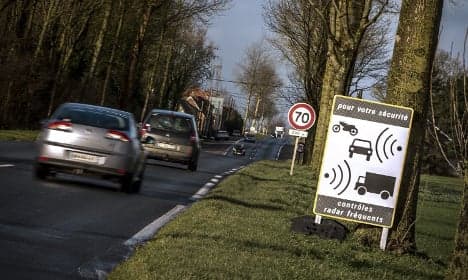France rolls out fake speed cameras (but where are they?)

France has rolled out the first of 5,000 dummy speed cameras in the hope of tricking motorists into driving more safely in a bid to cut rising road deaths.
Fake speed cameras have been installed along one of France's most dangerous roads, in the hope of tricking motorists into driving more safely.
The new 'dummy site' consists of eleven signs warning of frequent speed checks – but only one actually has a camera behind it, and drivers have no way of knowing which one. To make things even more difficult, the working camera will be moved around regularly.
The "luring signs" have been installed along a 37km stretch of road in Pas-de-Calais, between Aubigny-en-Artois and Le Parcq, which has been marked out as particularly dangerous. Six people have been killed and 28 others injured there over the past five years.
Following an increase in road deaths two years in a row, the government is hoping to crack down on dangerous driving without having to install more speed cameras. The new dummy sites target those drivers who slow down at the sight of a speed camera but, having safely passed it, immediately put their foot on the pedal.
More dummy sites are to be set up, with 100 dangerous roads to be covered by the end of 2016. The plan is to increase to 1,000 roads, protected by 5,000 dummy camera sites, by the end of 2010.
However, Pierre Chasseray from organization 40 million motorists, criticized the installation saying the measures would not “resolve traffic incidents”.
The move also met with criticism from the League against Road Violence, whose president described the technology as “obsolete”, adding that some drivers use alarm systems alerting them to the presence of speed cameras.
In January, Interior Minister Bernard Cazeneuve announced that 3,464 people had been killed from road accidents in 2015, an increase of 2.4 percent from the previous year, which he put down to “risky behaviour”.
Comments
See Also
Fake speed cameras have been installed along one of France's most dangerous roads, in the hope of tricking motorists into driving more safely.
The new 'dummy site' consists of eleven signs warning of frequent speed checks – but only one actually has a camera behind it, and drivers have no way of knowing which one. To make things even more difficult, the working camera will be moved around regularly.
The "luring signs" have been installed along a 37km stretch of road in Pas-de-Calais, between Aubigny-en-Artois and Le Parcq, which has been marked out as particularly dangerous. Six people have been killed and 28 others injured there over the past five years.
Following an increase in road deaths two years in a row, the government is hoping to crack down on dangerous driving without having to install more speed cameras. The new dummy sites target those drivers who slow down at the sight of a speed camera but, having safely passed it, immediately put their foot on the pedal.
More dummy sites are to be set up, with 100 dangerous roads to be covered by the end of 2016. The plan is to increase to 1,000 roads, protected by 5,000 dummy camera sites, by the end of 2010.
However, Pierre Chasseray from organization 40 million motorists, criticized the installation saying the measures would not “resolve traffic incidents”.
The move also met with criticism from the League against Road Violence, whose president described the technology as “obsolete”, adding that some drivers use alarm systems alerting them to the presence of speed cameras.
In January, Interior Minister Bernard Cazeneuve announced that 3,464 people had been killed from road accidents in 2015, an increase of 2.4 percent from the previous year, which he put down to “risky behaviour”.
Join the conversation in our comments section below. Share your own views and experience and if you have a question or suggestion for our journalists then email us at [email protected].
Please keep comments civil, constructive and on topic – and make sure to read our terms of use before getting involved.
Please log in here to leave a comment.